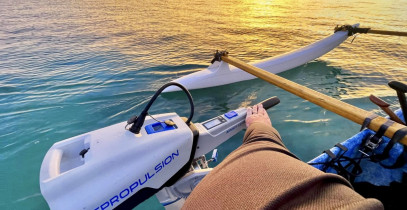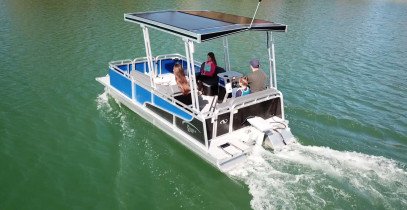
Spirit 1.0 is an electric outboard, not a trolling motor.
Trolling motor has three mount types, bow mount, transom mount and engine mount. A transom-mount trolling motor looks similar to Spirit 1.0. Sometimes people get confused with Spirit 1.0 and a transom-mount trolling motor. They’re designed for different purposes with respective advantages. This blog helps you to know the differences and make a correct purchase.

Primary Power vs Auxiliary Power
Spirit 1.0
Outboard is used as the primary power to propel the boat. To go 6 miles with a RIB or a dinghy, to leave the marina with a 24-ft sailboat, to go boating in saltwater, you should use Spirit 1.0 because it has the larger dynamic horsepower.
Trolling Motor
It's used as the auxiliary power for low speed. The large horsepower gas-engine has low energy efficiency and limited maneuverability at low speed. So those large horsepower outboard owners need a trolling motor for low-speed and short-distance maneuver, especially in fishing. Usually, you will see a trolling motor and a large horsepower gas outboard together on the same fishing boat.

Lithium Battery vs Lead Acid Battery
Spirit 1.0
It’s powered by a compact and lightweight lithium battery of 1018 Wh and 8.8 kg. It could even float! Just one piece, you don’t need any extra component to make it work. At 80% depth of discharge, it has 800 cycles of battery life. You could use it for years. The Spirit battery is well sealed and protected by the housing, so it’s worry-free for saltwater use.
Trolling Motor
It’s powered by the lead-acid battery. It’s heavy as it has only 1/4 energy density as the lithium battery. Most of the times, it’s 12V and you need a serial connection for 24V which means you carry more battery units. To extend the runtime, you need a parallel connection with more battery units. It's never easy to carry them home for charging because of the weight. To protect the battery on the boat and for saltwater use, you need a battery box. Normally, the battery life is two years and you need to buy new ones after they’re dead.
Highly Integrated vs Self Configuration
Spirit 1.0
The motor, controller, battery and charger all come together. They’re highly integrated as one product. You just unbox and go to the water.
Trolling Motor
You need to configure the system by yourself. Buy motor and battery from different brands. Calculate the battery amount you need with electrical formulas. Should you buy AGM or Gel battery? Flooded or sealed battery? Buyers could be at a loss when selecting the lead-acid battery. After that, select battery connector cable, a circuit breaker and a charger for your battery pack and you know you need them for sure. However, you’re not sure if you need a battery box or a third-party battery meter as the first-time buyer. It takes a while for you to figure out your system configuration because it consists of products from different suppliers.
Smart vs Dumb
Spirit 1.0
You could read realtime power in watt, remaining runtime to the accuracy of minute, and voltage from the display. Check the error code and fix the error.
Trolling Motor
You need a third-party gauge to read the voltage and capacity. It’s impossible to know the remaining runtime to the accuracy of the minute. You could estimate a rough remaining runtime according to the voltage based on your experience.
Propeller
Spirit 1.0
Optimized for all speeds. In fact, Spirit 1.0 with static thrust 71 lbs can go faster than Minn Kota Riptide Ulterra with static thrust 112 lbs on the same boat.
Trolling Motor
Designed for low-speed trolling only. Normally the maximum speed of a trolling motor is 4 mph regardless of how many pounds of thrust. Higher pounds of thrust will not move a boat faster.
It’s not that which one is superior to the other. Spirit 1.0 and transom-mount trolling motor are different things designed for different purposes. They have an overlap area of small dinghies and inflatables. When you look for a motor to propel your dinghy or RIB, you should know Spirit 1.0 is not a trolling motor, but a true electric outboard of great performance and user experience.









